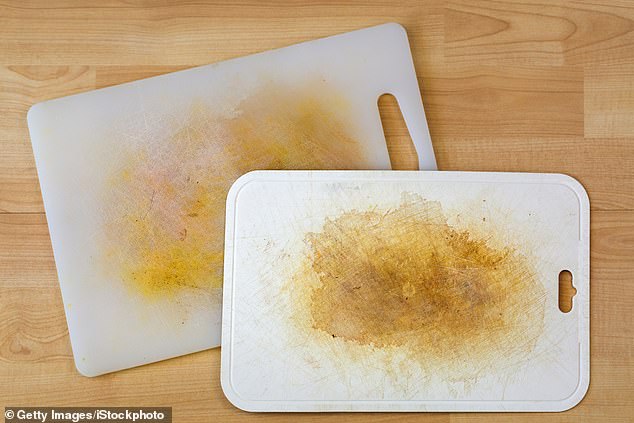How your cutting board produces tiny bits of plastic that can get into your brain and give you dementia: As scientists reveal alarming new research, the ways to keep yourself safe
As far as our bodies are concerned, Planet Earth is now Planet Plastic.
Tiny plastic particles – microplastics – in the air we breathe, our food and water and many of the products around us contaminate our bloodstream and organs, with potentially serious health consequences.
The particles have previously been linked to lung disease, liver failure and fertility damage in men.
But now two new studies have shown something more alarming: that even our brains are being invaded with these plastic pieces, potentially increasing the risk of dementia and Parkinson’s disease or causing developmental problems in children.
This invisible plague comes in the form of tiny particles classified as microplastics (as small as 0.0001 mm) and nanoplastics (even smaller particles – as small as a billionth of a centimeter, 0.000000001 cm).
On average, we ingest about 5 grams of plastic particles every week – the same weight as a credit card – according to a 2019 World Wildlife Fund study based on data from 50 previous studies. Over a year this amounts to 260 grams, or half a pound.
Numerous studies show that many of these plastics can be highly toxic.
Research shows that microplastics can settle in our organs and cause dangerous inflammation. Microplastics can also transport infectious bacteria and viruses.
Tiny plastic particles – microplastics – in the air we breathe, our food and water and many of the products around us contaminate our bloodstream and organs
Until now, most scientists believed that our brains are safe from plastic invaders because they are protected by the blood-brain barrier, a layer of specialized cells that acts as a filter, keeping out toxins and infections.
But the two new studies suggest that microscopic plastic particles are small enough to slip past the blood-brain barrier in the brain.
The first study, published in September in the journal Environmental Health, analyzed the brains of 15 people who had died from various causes and found microplastic particles in eight of them, particularly in the olfactory bulbs.
These pair of round masses of tissue at the base of the brain transmit information about odors from the nose to the brain. Crucially, this route is a weak spot in the blood-brain barrier.
Luís Fernando Amato-Lourenço, an environmental engineer at the University of Berlin who led the research, suggests that inhaled microplastics can bypass the blood-brain barrier by causing nasal mucus to flow up and mix with brain fluids around the olfactory bulbs, through small ‘perforations’ in the nasal mucosa. bony structures found in this area.
The olfactory nerve, responsible for transmitting odor information, is located just below the anterior and prefrontal lobes – areas of the brain involved in thinking, judgment and problem solving.
The most common type of plastic found was polypropylene, which is used in a wide range of plastic packaging, clothing and home accessories – suggesting that ‘indoor environments are a significant source of inhaled microplastics’, the researchers said.
Co-researcher Thais Mauad, associate professor of pathology at the University of Sao Paolo in Brazil, warned: ‘What is worrying is the ability of such particles to be internalized by cells and change the way our body functions.’
The findings “should raise concern amid the rise in neurodegenerative diseases such as Parkinson’s disease,” the report said.
Experiments with mice have already shown how microscopic plastic particles can damage the brain. For example, a 2022 study in the journal Chemosphere found that microplastics cause chronic inflammation that damages brain cells.
Two years earlier, a study from Rutgers University in New Jersey in which pregnant mice inhaled microplastics found that the particles were passed on to the next generation – in the organs and brains of the fetuses.
Another new study in humans suggests that microplastics can also enter our brains through the food and drinks we consume.
The researchers, led by Dr. Matthew Campen, professor of pharmacology at the University of New Mexico, examined brain, liver and kidney samples from post-mortem examinations of 51 local men and women.
The scientists were surprised to find up to thirty times more microplastics – mostly polyethylene – in brain samples than in the liver and kidneys.
They theorized that this could be due to the high blood flow to the brain, which carries plastic particles from organs such as the liver and kidneys. It is thought that the particles accumulate there because the brain – which is protected by the blood-brain barrier – is less efficient at removing toxins than other organs.
Professor Campen’s research, which has yet to be peer-reviewed, also shows that the amount of plastic in brain samples increased by around 50 percent between 2016, when the first samples were taken, and 2024, which may reflect the increase of human exposure to environmental factors. plastic pollution.
This view was shared by Professor Richard Thompson, an expert on plastic pollution at the University of Plymouth, who warned that environmental pollution (from microplastics and nanoplastics) could double by 2040.
Rather than wait for further evidence of harm to humans, Professor Thompson says we need to reduce plastic pollution now.
A good starting point for most of us, he told the Mail, is “single-use items such as plastic bottles.”
What other steps can we take to protect our brains from exposure to microplastics?
WEAR NATURAL FIBERS
According to a 2020 study by the Organization for Economic Co-operation and Development (OECD), up to 65 percent of all microplastics floating in our household air could come from synthetic fiber clothing.
This warns that the microscopic particles are excreted whenever we wear or dry clothes made of plastics such as polyester, acrylic and nylon indoors.

Choosing clothes made from cotton, wool and silk can reduce your risk
More than 80 percent of clothing from fashion brands contains plastic, according to a 2021 analysis of 10,000 items by the Royal Society for the Arts.
Such clothing contributes significantly to the fact that concentrations of microplastics indoors can regularly be 60 times higher than outdoors, according to environmental researchers from the University of Portsmouth.
A potential risk is the effect of such fibers on the lungs.
Two years ago, a University of Hull study of samples from living people found microplastics deep in the narrow airways of the lungs.
In separate research earlier this year, Barbro Melgert, professor of respiratory immunology at the University of Groningen, found that synthetic fibers in textiles make it more difficult for the lungs to recover from infection or injury.
It’s difficult to avoid these materials altogether, but if you choose clothing made from cotton, wool, and silk, you can reduce your risk.
CHOOSE WOODEN FLOORS AND WOOL CARPETS
Carpets are a ‘major source of microplastics in indoor air’, warned this year in a study by environmental scientists at the University of Birmingham, which examined plastic pollution in the air in 30 homes across the city.
They found that having carpet was associated with a 20 percent increase in the amount of microplastics in the air, compared to indoor spaces without carpet – although a 2020 study put this figure higher and estimated that having carpets increased the amount of microplastic fibers in the air. house can double.
Research shows that plastic fibers are plentiful in most British mass market carpets. Choose natural flooring products made from wool, sisal, jute or seagrass; wooden floors and natural carpets also do not produce microplastics.
DISCARD THE MICROFIBER BEDDING
Synthetic microfiber or hollow fiber bedding is another major source of microplastic indoor air pollution.
These very fine synthetic fibers are cheap to mass produce and are created as a man-made equivalent of natural down.
The most common plastic in bedding is polyester, and the most common polyester in bedding is polyethylene terephthalate, or PET. This is made from chemicals, including substances extracted from oil and sometimes coal.
Plastic fibers from bedding, carpets and furniture were the dominant type of microplastic found in the University of Birmingham study, which looked at plastic in the home, making up around 60 percent of all samples taken.
Try using natural fiber sheets and covers – and consider duvets filled with natural goose or duck feathers. An alternative to feathers are cellulose fibers processed from wood pulp.
BUY VINTAGE FURNITURE
Many modern pieces of furniture have plastics in the upholstery, as well as plastic foam fillings.
Even furniture made from non-plastic material – such as leather – can still have cushions made from polyurethane foam that will eventually produce microplastic dust.
Modern second-hand furniture is also often made from materials that release microplastics and impregnated with older fire-retardant chemicals linked to cognitive problems, fertility problems and allergies.
One option is modern wooden items with plastic-free wool cushions. Alternatively, good vintage and antique furniture made with horsehair can offer a plastic-free way forward.
WASH WITH A WET CLOTH
You can reduce microplastic dust and microfibers in your home by regularly using a vacuum cleaner with HEPA or S-class filters and mopping and wiping surfaces with a damp cloth (dry dusting removes small particles). blown into the air).
SLEEVE PLASTIC CUTTING BOARDS

Boards made from polyethylene or polypropylene can expose people to as many as 79.4 million microplastics annually
Reduce the intake of microplastics by using wooden cutting boards in the kitchen.
Dishes made of polyethylene or polypropylene can expose people to as many as 79.4 million microplastics annually, according to a study last year by scientists at North Dakota State University.
